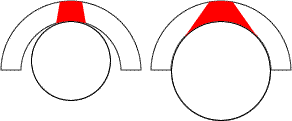Safety and Security.. Cycling Helmets
Helmet Facts
You can find the London Cycling Campaign policy on compulsory helmet usage here.The Bicycle Helmet Safety Institute a pro helmet body has its own website which you might like to visit.
Here is the abstract from a UK study on the effects of cycle helmets: the main finding: if pedestrians and motorists wore helmets it would save 12 times more lives than if cyclists wore them. - The pattern of injury in fatal pedal cycle accidents and the possible benefits of cycle helmets; Kennedy A. PMID 8799597
Here is the abstract from another paper on the issue, the finding: the evidence on cycle helmets is limited and safety efforts should focus on accident reduction rather than on injury reduction. - Pedal cyclists, crash helmets and risk; McCarthy M. PMID 1767006
The Transport Research Laboratory report 'Cycle Helmet Wearing in 1996' showed that overall wearing rates for cycle helmets in the UK is around 18 percent of cyclists
(this figure is probably higher today).
An extremely interesting argument and tons of supporting facts and figures can be found here.
There is an internationally collaborative group of individuals ranging from Doctors to cycling safety experts, statisticians and people with professional involvement in helmet design and performance. This group has it's own, very informative website here: http://www.cyclehelmets.org
Wearing a helmet could save your life. Fact or Fiction?
The truth is that there is no simple answer. Certainly, in some accidents a helmet can reduce the risk of severe head injury but every accident is different and therefore the outcome can never be judged before the incident. Indeed the majority of head injuries which result in death are caused by collision with other vehicles, travelling at comparative high speed, something which a bicycle helmet is not designed to cope with (See "What can a helmet do?" below). In reality, the numbers of these serious head injuries is extremely low and it is felt that the overall health benefits offered by regular cycling far far outweigh the small amount of risk involved.
Is it compulsory to wear a helmet?
Currently in the UK there is no legislation which places any requirement on you to actually wear a helmet. Whether to wear a helmet or not is currently a matter of personal choice (the majority of the cycle industry wishes it to remain that way).
There are both pro compulsory and anti compulsory arguments, both of which are simply too complex to publish here.
Sadly, there no longer appears to be a single site which thoroughly represents BOTH sides of the compulsion argument and as such it is down to you to make up your mind. The two main sites to look at at present appear to be:
Pro Compulsion: The Bicycle Helmet Safety Institute
Anti-Compulsion: http://www.cyclehelmets.org
If someone knows of a better Pro Compulsion site for us to direct visitors to, please let me know!
There are both pro compulsory and anti compulsory arguments, both of which are simply too complex to publish here.
Sadly, there no longer appears to be a single site which thoroughly represents BOTH sides of the compulsion argument and as such it is down to you to make up your mind. The two main sites to look at at present appear to be:
Pro Compulsion: The Bicycle Helmet Safety Institute
Anti-Compulsion: http://www.cyclehelmets.org
If someone knows of a better Pro Compulsion site for us to direct visitors to, please let me know!
What can a helmet do?
As with most safety orientated products, bicycle helmets have to pass certain standards prior to being allowed to be sold. What may be surprising is the exact nature of those standards.
Cycle helmets are only designed and tested to withstand an impact equivalent to an average weight rider travelling at a speed of 12 mph falling onto a stationary kerb shaped object from a height of 1 metre.
This is the equivalent of falling from your bike onto the road or the kerb edge.
Helmets are not tested nor expected to be able to offer full protection if you come into contact with a vehicle which is moving.
Helmets are not tested nor expected to be able to offer full protection if you come into contact with a vehicle which is moving.
The importance of size.
If you decide that you should wear a helmet then for that helmet to be able to offer you any worthwhile protection it must be the correct size AND fit.
To understand why size and fit is so important, you need to understand how a helmet works.
Bicycle helmets are manufactured from expanded foam polystyrene, similar to the type of stuff polystyrene coffee cups are made from. Polystyrene is structurally rigid and can be moulded into virtually any shape. However whilst being structurally rigid, it is a material which is easy to damage by crushing because it contains a high number of tiny air pockets. The process of crushing absorbs energy. It is these facts which make it ideal for the construction of bicycle helmets.
Any moving object has energy. To stop an object from moving, this (kinetic) energy must be removed by conversion to other energy forms, eg heat and sound OR by using it to alter the chemical or structural composition of a material. Cars have "crumple zones": the front end is designed to concertina, absorbing terrific amounts of energy but whilst bringing the car to a halt (decelerating it) less abruptly and hopefully protecting the driver/passengers by lessening the effects of the impact on them. But there is only so much energy that can be absorbed by this crumple zone, and at higher speeds (increased speed = increased kinetic energy) insufficient energy can be absorbed to adequately protect the occupants. A helmet is designed to work in a very similar way, the polystyrene acting as the crumple zone, lessening the impact on the skull. The helmet will make contact first and stop moving. However, because it can be crushed, the head inside it is allowed to carry on moving for a short period of time as it crushes the polystyrene, an amount of energy being absorbed in the process. Because the skull is decelerated slightly more gradually, there is a lesser impact between both the skull onto the ground AND subsequently the brain onto the inside of the skull. Brain damage occurs if the impact between it and the skull is too great, ie too much energy has to be absorbed by the brain.
The maximum amount of energy is absorbed if the impact area is at its largest, but as the impact area decreases, so does the amount of energy that can be absorbed. If we look back at the example of a car, modern crash safety tests now include a test which only involves half of the crumple zone because very few real collisions involve a perfect head on impact. Cycle helmet standards also try to follow this principle, hence the impact test against a "kerb" shaped object.

The illustration above is designed to demonstrate the effect of a helmet which does not fit correctly. On the left, the helmet is not a snug correct fit to the head. On the right, the helmet fits snugly and touches the head at all points. The red areas denote the effective crumple zone in each case. As you can see, the area covered when the helmet is the correct size is quite noticeably larger than that in the helmet which does not fit. This in turn means that there is less material which can be crushed leading to less energy absorption.
Try it on before you buy!
You should try on a number of helmets before buying. Each manufacturer uses a different "model" head form and even same size helmets can be dramatically different. The helmet should be close fitting all the way round. Minor gaps can be filled using the soft foam pads generally supplied. Some helmets use a "sizing ring" which adjusts to fit your head. If this is the case, ensure that the helmet shell is fairly close fitting. Do not rely solely upon the snug fit created by the sizing ring. The sizing rings and soft foam pads offer absolutely NO protection. Only the polystyrene shell will absorb any energy and it is therefore very important that this shell be as close a fit to your skull as possible without it being uncomfortable.
Price vs. Features.. Are all helmets created equal?
Although all helmets available comply with the same basic safety standards (there is an American based Snell B95 standard which a few UK available helmets pass and which is more stringent than the basic standard required for sale in the UK), there is a big variation in cost - so if they're all as safe as each other, what does your extra money get you? and is it worth spending extra?
- cycle helmets can get a bit warm, especially in summer. More expensive helmets generally have more air vents and better internal airflow to keep your head cool, BUT this can often reduce the amount of polystyrene meaning that the amount of energy the helmet can absorb *may* be reduced.
- comfort is a very important issue with helmets - if a helmet is uncomfortable, then you're less likely to wear it, and it is useless if you leave it at home! More expensive helmets may have fancier fitting systems, which make them more comfortable and easier to fit.
- some more expensive helmets have a crash replacement policy - they give you a replacement at a reduced price - so you are buying an insurance policy along with the helmet!
- fit - Helmets created by the big name specialists in bicycle helmet production are generally in receipt of exhaustive research and design. The fit is often better and more accurate to real head shapes and as a result the comfort is higher.
Closing thoughts...
The safety benefits offered by wearing a helmet do exist, but these benefits should be neither over-estimated nor under-estimated. Surely anything which can offer an extra amount of safety is worthwhile as long as it does not leave you with a false sense of security.
We would recommend the wearing of a correctly fitting and fitted bicycle helmet but ultimately the decision to wear a helmet or not has to be a matter for the individual.

